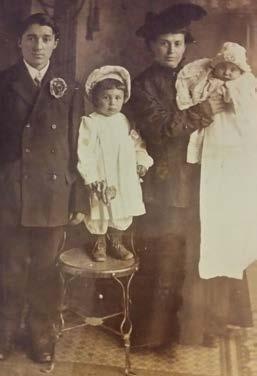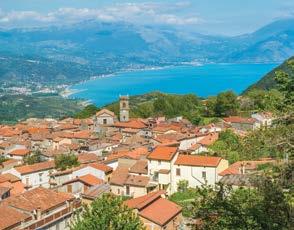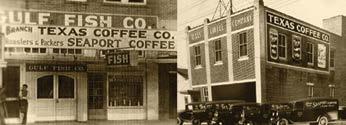
15 minute read
KEEPING A PROMISE
My grandfather lived life like a storied superhero. He was strong, determined, independent, an achiever of incredible feats. During long car rides in his Cadillac, he recounted how he befriended billy goats as a child in Italy and how he swam across the Hudson River at age 14.
Francesco Torre was born on January 28, 1905 in Yonkers, New York. In 1908, his mother, Maria (née Marotta), relocated her young family (my toddler grandfather, his four-month-old brother, and her husband) to San Giovanni a Piro, her birth town in the Campania region. She was determined to fight for her land.
Advertisement
“Two of my sisters were born there,” my grandfather told me. “And while my mother went to Naples for an operation and my father returned to New York to work for our return passage, I was responsible for my siblings.”
“And what did that entail?” I asked him. “You were a child yourself.”
That’s when I heard the billy goat story again.
“Did you know goat’s milk is closest to mother’s milk?” he asked.
I shook my head.
“My mother was away for months, so twice a day, morning and early evening, I walked from my town at the top of the hill to get milk for Aunt Jean. I knew to make friends with the billy goat, bringing him an apple or piece of fruit or bread. He was the boss of the other goats, and he sort of protected me. I filled my canteen jug with fresh goat’s milk and walked back home.”
My education professor-self, fully aware of research literature that correlates childhood experiences to character traits, nagged me to find out more. I sought help from Dr. Maurizio Tuliani, a native Italian middle school teacher and researcher fascinated by my family story, who volunteered to locate a name and contact information at the commune in San Giovanni. He wrote in an e-mail:
Barbara, molto interessante. Lunedì provo a telefonare all’Ufficio del Catasto per sapere se ci possono aiutare. Poi ti faccio sapere.
Barbara, very interesting. On Monday, I’ll try to call the office in Commune di San Giovanni a Piro to see if they can offer help. I’ll let you know. ***
With two weeks left in my semester abroad work assignment in Siena, I travel 500 miles by bus and two trains to Salerno, where I secure lodging at a bed and breakfast. When I log onto the computer, my eyes settle on an email from Dr. T.
KEEPING A
A Journey to My Grandfather’s Town
BY BARBARA TORRE VELTRI
His message is simple:
“Are you okay? Did you get to Salerno? Good luck tomorrow when you visit your grandfather’s land. Keep my phone number handy to be safe.”
The next morning, I board the local train bound for Sapri, a city that borders the Tyrrhenian Sea. After arriving at the train depot, I expect things to unfold as if I were a sightseer simply touring a basilica open to the public. To my surprise, the bus to San Giovanni a Piro doesn’t arrive for two hours. Waiting alone in a circular courtyard, locals peer at me through veiled, lace-curtained windows. Some openly stare from tiered balconies. I am a stranger in a commune that prides itself on knowing everyone.
I board the minivan-sized vehicle and hand two euro to the driver.
“Signora, dove?” he asks. Madam, where are you going?
“San Giovanni a Piro,” I say.
He nods, and I settle into a leather seat on the left side of a narrow aisle. The minibus travels a road parallel to the sea, but soon, lush green hills and an assortment of fruit trees dot the mountainous terrain. We make three stops in 15 minutes. The curved, elongated path toward Scario is still eight miles south of San Giovanni a Piro, my destination. The bus zigzags through a single-lane switchback mountain road. The driver shifts gears unevenly and with every gain in altitude, nausea comes over me. I open a window and fix my gaze on the incredible view. On the left, ominous clouds of deep gray transform the sea into a mystical body. Halfway up the mountain, the bus stops unexpectedly. The driver heads to an auto body shop on the right, leaving us passengers on board.
I gaze out the left-side window and blink twice to ensure that my eyes are not deceiving me. Perched on the roof of a wooden shed the size of a doghouse stands a male billy goat with horns and beard protruding from his chinny-chinchin. He exudes confidence and dominion over the nanny and kid goats grazing on the grass encircling his castle.
My chest heaves uncontrollably as tears cascade down my cheeks. Could those be descendants of the same goats who supplied milk for my great-aunt Jean more than a century ago when five-and-a-half-year-old Francesco walked six miles each way to secure food for his baby sister?

Barbara sits upon the steps of Chiesa di San Gaetano, where her grandfather made his First Holy Communion. Francesco Torre (on the chair) with his parents and brother in New York before they returned to Italy.

Is this synchronicity, the timing of the driver’s stop at the exact spot where the billy goat stands with his head held high on that worn-out roof?
Overwhelmed with emotion, I barely have the presence of mind to take a photo before our absentee driver resumes his position behind the steering wheel.
The crest of the town is within sight as the bus slows to a crawl, this time out of respect for a funeral procession for a deceased member of the community. The driver signals to me, one of only two passengers still seated, that this is my stop. I ask the driver what time the evening bus leaves San Giovanni a Piro to return to the Sapri Train Station.
With limited patience, he shouts, “Non autobus oggi! L’autobus andava domani!” (There is no bus today! The bus will come tomorrow!)
Trembling and grasping the chrome handlebar with every ounce of strength that I have, I am ready to collapse right there on the top step of the bus. I have not considered this option—arriving in my grandfather’s town with no
(Stefano Valeri)

place to stay, no way to leave, no one to take care of me, and no return bus leaving until tomorrow.
My face registers panic as my inner voice is screaming at me. Now what are you going to do? Get off or remain planted where you are?
The driver, noting my shock and emotional instability, stops his rant and tells me that a bus from Scario leaves at 6:30 p.m.
‘Scario!’ I think with heart and mind racing. ‘That’s eight miles down the mountain’s narrow, windy, unlit road! Even the billy goat house is closer!’
I descend the steps one at a time and stand immobile on the street. It is 4:00 p.m. I am in the land of my grandfather, speak limited Italian, stick out conspicuously as “la straniera,” and have no idea of what to do. “Gramp,” I pray aloud. “I know that you see me, but I’m scared to death right now, and I need help with this.”
Whether real or imagined, I hear words that resemble his own voice. “All right, Barbara. It’s all right.”
I stare at Dr. T’s Italian script on quadrille notebook paper, which has the address for the Municipal building written on it. When I look up, I notice the matching street name chiseled into the cornerstone of the building across the street.
I walk the stone strada for a quarter of a mile before I am standing in front of the Municipio building, located on the right side of the street with a panoramic view that extends to the Tyrrhenian Sea.
The massive wooden doors are unlocked, so I peer into a 15-foot covered vestibule to notice a flight of stairs to the right. I follow the sound of voices to the third floor. When I get there, three people, employees of the Municipio, look at each other, then at me.
One woman asks, “Chi e lei?” (Who is she?) Two respond in unison, “Non so.” (I don’t know.)
One notes curtly, in Italian, that the office is closed.
Looking haggard, I stand before a woman about my age who is dressed so well that I wonder what she is doing here, in the middle of a mountain-top city. Her designer silk print dress, paired with textured tights and high heels, fits well and is stunning.
At this point, I produce the paper with the name of the Municipio employee that my friend in Siena contacted as a point of reference prior to my making this journey.
Immediately, the well-dressed woman questions me. “Why do you want to see this man, my colleague?” she asks.
Three sets of eyes fixate on me. I offer an explanation in my best Italian (which is the best that I have after three-and-a-half months in Italy). “I am here to see my grandfather’s town and find out where the family lived when my Aunt Jean was born.”
They are neither impressed nor empathetic. They tell me to return on Monday at 9:00 a.m. as offices are closed on Friday for the May 1 Worker’s Day national holiday. But I’m here on Wednesday, April 29. At this point, I shake internally and doubt the wisdom of my journey. But somehow, I find my voice.

“I cannot come back on Monday. by 18:10 (6:10 p.m.). When I finish I am a U.S. professor teaching univer- work, I will drive you to the station.” sity students in Siena. This is my only I locate the church of San Gaetano, chance to see, with my own eyes, where where my grandfather made his First my grandfather lived as a young boy for Holy Communion and his sisters were five years.” baptized. I purchase homegrown
I pull out a frayed copy of a photo goods, produtti tipici, to share with of my grandfather, Francesco Torre, at family. The female shop owner takes age 90. In it, he is next to a framed im- one look at the family photo and zeros age of his parents, Dominic and Maria in on my great-grandmother, Maria Marotta Torre, on the occasion of their Marotta. She points to her, stating 50th wedding anniversary. emphatically, in Italian, “She has people “I am the family ambassador,” I here.” manage saying with my quivering voice Germanna’s red Alfa Romeo hugs that can’t hold back tears any longer. “I took the last bus here and don’t know The municipal building in San Giovanni a Piro, where the workers came to the the winding roads and in no-time we are riding along the sea. She pulls her how to get back to Salerno, where I’m author’s much-needed aid. convertible into a parking lot and urges staying tonight!” me to get a close-up view of the sea.
My head is spinning from physical So I step onto the shore. The waves and emotional exhaustion. I have researched my family ebb and flow, lapping the shore with a smooth, yet perhistory for months only to arrive at this end. I am spent, sistent cadence. vulnerable, and socially naked. The younger woman heads My senses cry out: Barbara, take it all in. Remember to a separate office and makes a phone call to check on the the smell of the sea, the sound of the cascading waves, the site birth of Giovanna Torre (Aunt Jean) on November 14, of the mountains that reach up to the heavens, and above all, 1910. I find out that this lady is actually la sindica—the how your heart feels right now, at this very moment.city’s mayor. Germanna interrupts my reverie and points to the
I stand alone in front of the well-dressed woman, Gerstatue, The Statue of Christ the Redeemer. “This is the manna. She speaks in English and tempers her tone. “I second one in the world,” she states with pride. “The only live in Sapri,” she tells me. “You can take the 19:10 (7:10 other is in Rio de Janeiro, Brazil.” p.m.) train back to Salerno. Go see the town and return I strain to make out the form, obscured by a dominating line of tightly knit clouds. As promised, Germanna drops me off in front of the Sapri train station in time for the train back to Salerno. I thank her for being my angel. We embrace (kiss on both cheeks), and I give her an American hug. She peers into my eyes and speaks warmly. “You did a good deed today for your family,” she says. “It is my pleasure to meet you. Not many people even care about those who went before them. They take it all for granted. Safe travels.” On the train ride to Salerno, my breath returns to normal, as a purpose-filled sense of peace envelops me. My grandfather is smiling, all knowingly, as I shake my head and realize that all of his stories were true. Francesco Torre (center) with Barbara’s uncles and father at a Torre family reunion 20 years ago. Barbara Torre Veltri, Ed. D (Barbaraveltri@icloud.com) is an Associate Professor of Education at Northern Arizona University and OSDIA member of the Scottsdale Lodge in Arizona.

MASSACHUSETTS
In spite of the pandemic, the Methuen Lodge #902 has forged avanti, connecting with each other through Zoom meetings and holding weekly bingo along with quarterly fundraising, meat/seafood/wine raffles, and a 50/50 drawing.
In addition to these activities, the Methuen Lodge Community Center Trust (CCT) completed its “Memorial Walkway” project on a cold and windy December weekend. The brick walkway was laid in front of the Methuen Lodge’s building.
“Grazie mille to all of our Sons and Daughters of Italy members as well as members of our community who purchased the engraved bricks thereby funding this project,” said CCT Chairman Pio Frittitta.

The Memorial Walkway completed by the Methuen Lodge Community Center Trust.
The lodge would like to specifically recognize:
Committee Members:
Ralph Bagarella, Co-Chair, current Lodge President; Armand Buonanno, Past Lodge President; Pio Frittitta, Community Center Trust Chairman; Dottie Crisa, Neil Perry, Brenda Buonanno, Barbara DeLucca Rea, and John Bonanno
Donors:
Anthony Perrone; Torromeo Industries Inc.; Ferris Landscaping; Mann’s Orchards; J. Clement Bonanno; Circle G. Giordano Family; Leonard Christopher
Volunteers:
Vincent Ruggieri, Ron Marsan, Anthony Estee, Brett Frittitta, Vince Tersigni, Bob Bonanno, Tim Ippolito, Bob Bundzinski, Salvatore Cianciolo, Mario Marchese, Bob DeFrancisco, Bob Hendry, and Ted Shields
Last fall, the Grand Lodge of New York’s Gift of Sight Committee donated $25,000 to the Guide Dog Foundation. The donation will be used to purchase a van that transports blind and visually impaired clients and their dogs. The van will bear the Order Sons and Daughters of Italy in America and the Gift of Sight logos.
The funds were raised during the last three highly successful Gift of Sight luncheon fundraisers. The donation is only part of the committee’s substantial contributions to a variety of organizations that assist individuals and veterans with visual issues.
NEW YORK
“I had the honor to participate in the ceremony,” remarked Anthony Naccarato, Grand Lodge of New York President, “and frankly, it was one of the highlights of my presidency. I congratulate the entire committee for their commitment and hard work in order to raise such a significant amount of funds.”
(L. to R.) Committee Treasurer Michele Sewitch, Committee Co-Chair Anthony D’Angelis, New York State Grand Lodge First Lady and Committee Chairperson Mary Naccarato, Community Fundraising Manager Jaime McGrade, and Grand Lodge of New York President Anthony Naccarato.

The Constantino Brumidi Lodge #2211 of Deer Park donated 20 gift bags to the residents of Maria Regina Resident Health Care Facility in Brentwood and 15 gift bags to the residents of Sunrise Assisted Living Facility in West Babylon. Lodge members made personal
(L. to R.) Lodge President Carmine Soldano, Susan Soldano, and Recreation Therapist Sabrina Feliciano at the Maria Regina Facility. Not pictured: Janeen Bush and Carol Nani NEW YORK
donations and also reached out to the community for cash donations and items in order to make the gift bags. The lodge then coordinated with the directors of the two facilities and, once approved, scheduled delivery of the Christmas Gift Bags.
The gift bags consisted of lap blankets, socks, coloring books, puzzle books, snacks, and various other items. The purpose was to give the elderly residents something enjoyable to do during the day, as visitation was extremely limited during the pandemic. The donations for the Maria Regina Facility were coordinated by lodge members Susan Soldano and Carol Nani through Janeen Bush, Director of Therapeutic Recreation. The donations for the Sunrise Facility were coordinated by lodge member Karen Lorito through Alexandria Garcia, Recreational Director.
TEXAS
(L. to R.) Recreational Director Alexandria Garcia and Lodge Treasurer Karen Lorito at the Sunrise Facility. Not pictured: Susan Soldano and Carol Nani.
“Our lodge was happy to donate these gift bags,” said Lodge President Carmine Soldano, who oversaw the delivery. “Hopefully, they brought a smile to the residents at both facilities during the Christmas season.”
La Famiglia di Southeast Texas Lodge #2887 of Beaumont celebrated a lodge member’s family company that turns 100 years old this year!
The Texas Coffee Company began in Beaumont, Texas, in 1921 when Charles J. Fertitta, Sr., recognized the demand for a good quality coffee. Charles began with an investment of $1,800, a Ford Model-T truck, a few pounds of coffee, and a one-room shotgun-style shack in back of the Crescent Market on Magnolia Street in downtown Beaumont.
In 1926, Mr. Fertitta formed a partnership with R. C. Maceo and Joseph S. Serio. They moved Texas Coffee Company to a larger, more modernized facility. With this new partnership, Mr. Maceo worked as the plant manager while Mr. Fertitta and Mr. Serio delivered their product in the Beaumont and Port Arthur territories. In 1968, Texas Coffee Company became the first coffee company in the United States to begin packaging coffee in vacuum-packed foil bags.
Today, Charles’s grandson (and lodge member) Donald Fertitta helps run the company, serving as the Vice-President of The Texas Coffee Company. His brother, Joseph, serves as President. The Texas Coffee Company is the parent company of Seaport Coffee, which has grown so popular with Texans that the Texas State Legislature has submitted a bill to make it the Official Coffee of Texas.
Photo circa 1931.





